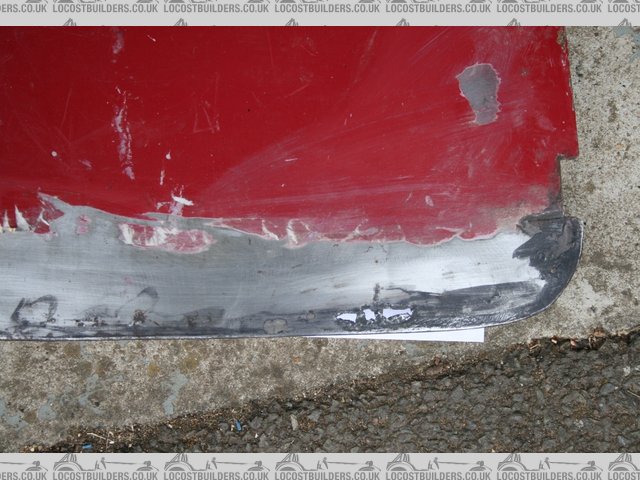SteveWallace
|
| posted on 21/6/17 at 04:48 PM |

|
|
MG TC Door Panel Repairs
I've started to work on the doors on my 1949 MG TC. These are wood framed with a metal outer skin. Stripping the paint of one of them has
revealed 3 smallish rust holes that had been previously repaired with filler. I've taken all of the old filler off, gone back to solid metal
and treated any remaining rust spots.
The skin is too thin and the holes too small to bother with cutting a section out and welding a new bit in (also too much risk of distortion).
Therefore, what is the best stuff to fill the holes with?
Its a classic car, so it maybe deserves something better than cheap filler. Therefore I was thinking maybe something like Isopon Metalik, but are
there better options for a repair of this type?
 
Description
"I know every nut and bolt and cog in that car, I built it myself" - The Prisoner, 1967
|
|
|
|
|
ste
|
| posted on 21/6/17 at 05:26 PM |

|
|
it can be done with glass fibre although there's nothing too hard about welding a patch in, but again, you will need filler to get the finish
|
|
|
theconrodkid
|
| posted on 21/6/17 at 07:04 PM |

|
|
lead ?.
who cares who wins
pass the pork pies
|
|
|
Vmax1974
|
| posted on 21/6/17 at 07:50 PM |

|
|
quote:
Originally posted by theconrodkid
lead ?.
Agreed thats what they would have used when it was new therapeutic to work with too
|
|
|
perksy
|
| posted on 21/6/17 at 09:19 PM |

|
|
Lead loading 
Watched an old guy do it on a classic car restoration course I did at the local college 
|
|
|
Mr Whippy
|
| posted on 22/6/17 at 06:05 AM |

|
|
personally since the door skin is flat I think I would just change it. I've done this on quite a few cars and it's by far the best
outcome. I think I'd use 1.5mm aluminium sheet for it rather than steel as it's easier to work and will last longer.
|
|
|
Mr Whippy
|
| posted on 22/6/17 at 06:07 AM |

|
|
quote:
Originally posted by perksy
Lead loading 
Watched an old guy do it on a classic car restoration course I did at the local college 
Don't think I'd use that due to the ash frame behind
|
|
|
907
|
| posted on 22/6/17 at 06:59 AM |

|
|
I'd replace that bottom edge with new steel welded in.
Distortion is caused by the weld and the area around it shrinking as it cools.
Counter this by welding 25 to 50mm, then with a dolly on the back planish the weld from the outside.
Ideally the weld needs to be proud and after hammering it will then be flat leaving just a flash over with a
sanding or flap disc to finish.
So to recap; weld a bit, hammer, weld a bit more, hammer, till the weld is complete.
Welds shrink and hammering expands.
If the car is worth the time then take the time to do a proper job and enjoy the learning curve.
Paul G
|
|
|
nick205
|
| posted on 22/6/17 at 08:04 AM |

|
|
I'd favour welding new metal in as well. Your going to have to paint it anyway so go for the better job and weld in some new sheets steel.
Having practiced a little myself MIG welding thin sheet steel I'd suggest practicing off the door first to make sure you're happy with the
technique.
ETA...there are some good videos on YouTube showing methods for welding thin sheet metal. I found these helpful when attempting it myself.
If there's space behind the door skin then a decent bit of copper stock (bar, block etc) will help by acting as a heat sink to draw heat away
and reduce distortion. Given the photo above though I can imagine it'll be tight on space behind the area being worked on.
Also be careful when working on the actual door not to burn the timber frame 
[Edited on 22/6/17 by nick205]
[Edited on 23/6/17 by nick205]
|
|
|
SteveWallace
|
| posted on 23/6/17 at 12:04 PM |

|
|
Your right, the correct long term solution is to weld a new bit in.
I do need to learn to weld at some point, but, for various personal reasons I feel like I need to make some progress, so I've just given it to
my local expert to do. There are other less sensitive bits that I can start my welding experience on later in the build.
Working around the wood is not a problem as I've taken all of the old wood out anyway.
The good news is that I've stripped the paint off the other door and its near perfect. The plan for that one is to spray it with etch primer to
protect it, put the new wood in, and then put the hinges on so that I can use it to correctly locate the front door pillar.
"I know every nut and bolt and cog in that car, I built it myself" - The Prisoner, 1967
|
|
|













